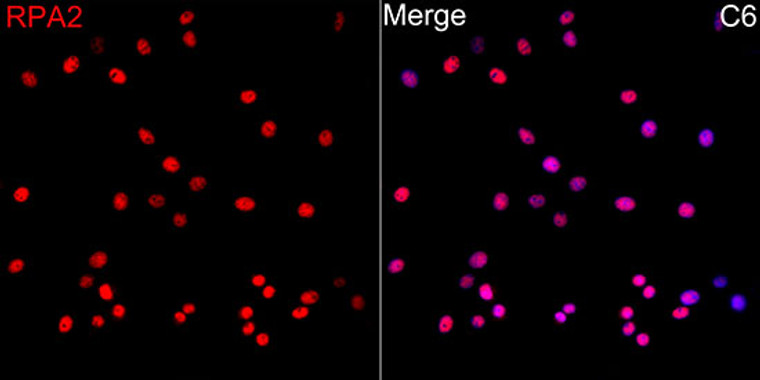| Host: |
Rabbit |
| Applications: |
WB/IHC/IF/IP |
| Reactivity: |
Human/Mouse/Rat |
| Note: |
STRICTLY FOR FURTHER SCIENTIFIC RESEARCH USE ONLY (RUO). MUST NOT TO BE USED IN DIAGNOSTIC OR THERAPEUTIC APPLICATIONS. |
| Short Description: |
Rabbit polyclonal antibody anti-RPA2 (80-270) is suitable for use in Western Blot, Immunohistochemistry, Immunofluorescence and Immunoprecipitation research applications. |
| Clonality: |
Polyclonal |
| Conjugation: |
Unconjugated |
| Isotype: |
IgG |
| Formulation: |
PBS with 0.02% Sodium Azide, 50% Glycerol, pH7.3. |
| Purification: |
Affinity purification |
| Dilution Range: |
WB 1:500-1:2000IHC-P 1:50-1:200IF/ICC 1:50-1:200IP 1:500-1:1000ChIP 1:500-1:1000 |
| Storage Instruction: |
Store at-20°C for up to 1 year from the date of receipt, and avoid repeat freeze-thaw cycles. |
| Gene Symbol: |
RPA2 |
| Gene ID: |
6118 |
| Uniprot ID: |
RFA2_HUMAN |
| Immunogen Region: |
80-270 |
| Immunogen: |
Recombinant fusion protein containing a sequence corresponding to amino acids 80-270 of human RPA2 (NP_002937.1). |
| Immunogen Sequence: |
IRHAEKAPTNIVYKIDDMTA APMDVRQWVDTDDTSSENTV VPPETYVKVAGHLRSFQNKK SLVAFKIMPLEDMNEFTTHI LEVINAHMVLSKANSQPSAG RAPISNPGMSEAGNFGGNSF MPANGLTVAQNQVLNLIKAC PRPEGLNFQDLKNQLKHMSV SSIKQAVDFLSNEGHIYSTV DDDHFKSTDAE |
| Post Translational Modifications | Differentially phosphorylated throughout the cell cycle, becoming phosphorylated at the G1-S transition and dephosphorylated in late mitosis. Mainly phosphorylated at Ser-23 and Ser-29, by cyclin A-CDK2 and cyclin B-CDK1, respectively during DNA replication and mitosis. Dephosphorylation may require the serine/threonine-protein phosphatase 4. Phosphorylation at Ser-23 and Ser-29 is a prerequisite for further phosphorylation. Becomes hyperphosphorylated on additional residues including Ser-4, Ser-8, Thr-21 and Ser-33 in response to DNA damage. Hyperphosphorylation is mediated by ATM, ATR and PRKDC. Primarily recruited to DNA repair nuclear foci as a hypophosphorylated form it undergoes subsequent hyperphosphorylation, catalyzed by ATR. Hyperphosphorylation is required for RAD51 recruitment to chromatin and efficient DNA repair. Phosphorylation at Thr-21 depends upon RFWD3 presence. DNA damage-induced 'Lys-63'-linked polyubiquitination by PRPF19 mediates ATRIP recruitment to the RPA complex at sites of DNA damage and activation of ATR. Ubiquitinated by RFWD3 at stalled replication forks in response to DNA damage: ubiquitination by RFWD3 does not lead to degradation by the proteasome and promotes removal of the RPA complex from stalled replication forks, promoting homologous recombination. |
| Function | As part of the heterotrimeric replication protein A complex (RPA/RP-A), binds and stabilizes single-stranded DNA intermediates, that form during DNA replication or upon DNA stress. It prevents their reannealing and in parallel, recruits and activates different proteins and complexes involved in DNA metabolism. Thereby, it plays an essential role both in DNA replication and the cellular response to DNA damage. In the cellular response to DNA damage, the RPA complex controls DNA repair and DNA damage checkpoint activation. Through recruitment of ATRIP activates the ATR kinase a master regulator of the DNA damage response. It is required for the recruitment of the DNA double-strand break repair factors RAD51 and RAD52 to chromatin in response to DNA damage. Also recruits to sites of DNA damage proteins like XPA and XPG that are involved in nucleotide excision repair and is required for this mechanism of DNA repair. Also plays a role in base excision repair (BER) probably through interaction with UNG. Also recruits SMARCAL1/HARP, which is involved in replication fork restart, to sites of DNA damage. May also play a role in telomere maintenance. |
| Protein Name | Replication Protein A 32 Kda SubunitRp-A P32Replication Factor A Protein 2Rf-A Protein 2Replication Protein A 34 Kda SubunitRp-A P34 |
| Database Links | Reactome: R-HSA-110312Reactome: R-HSA-110314Reactome: R-HSA-110320Reactome: R-HSA-174437Reactome: R-HSA-176187Reactome: R-HSA-3371453Reactome: R-HSA-3371511Reactome: R-HSA-5358565Reactome: R-HSA-5358606Reactome: R-HSA-5651801Reactome: R-HSA-5655862Reactome: R-HSA-5656121Reactome: R-HSA-5656169Reactome: R-HSA-5685938Reactome: R-HSA-5685942Reactome: R-HSA-5693607Reactome: R-HSA-5693616Reactome: R-HSA-5696395Reactome: R-HSA-5696397Reactome: R-HSA-5696400Reactome: R-HSA-6782135Reactome: R-HSA-6782210Reactome: R-HSA-6783310Reactome: R-HSA-6804756Reactome: R-HSA-68962Reactome: R-HSA-69166Reactome: R-HSA-69473Reactome: R-HSA-912446Reactome: R-HSA-9709570 |
| Cellular Localisation | NucleusPml BodyRedistributes To Discrete Nuclear Foci Upon Dna Damage In An Atr-Dependent Manner |
| Alternative Antibody Names | Anti-Replication Protein A 32 Kda Subunit antibodyAnti-Rp-A P32 antibodyAnti-Replication Factor A Protein 2 antibodyAnti-Rf-A Protein 2 antibodyAnti-Replication Protein A 34 Kda Subunit antibodyAnti-Rp-A P34 antibodyAnti-RPA2 antibodyAnti-REPA2 antibodyAnti-RPA32 antibodyAnti-RPA34 antibody |
Information sourced from Uniprot.org
12 months for antibodies. 6 months for ELISA Kits. Please see website T&Cs for further guidance









